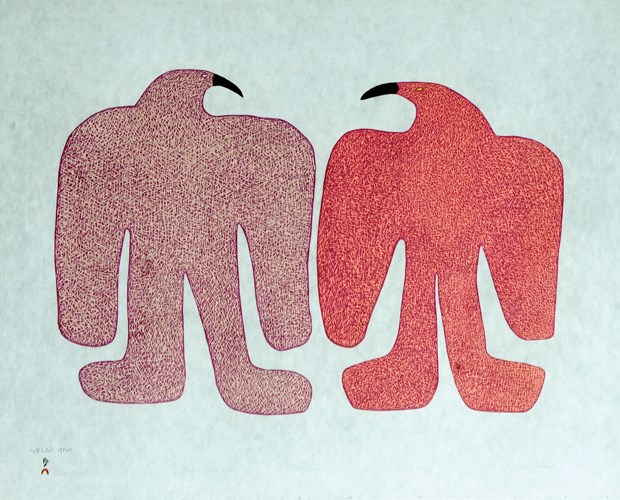Cape Dorset annual print collection for 2016 opens Saturday, Oct. 15. For more information visit inuit.net.
Simon Griffiths turned his passion for First Nations art into an enterprise after immersing in the Inuit culture.
The one-time airline industry employee would routinely fly in and out of Artic Quebec and watch the artists in their element.
“I spent time with the Inuit people and up North, and fell in love with their culture, their mythology, their artwork and just with the Inuit people in general,” says Griffiths.
He recalls one interesting evening in Inuit territory. Griffiths was leaving a home he had been invited to for dinner, when he noticed a commotion at the end of the gravel road in the remote community.
One of the local elders who had walked off into the woods a couple of months prior - which Griffiths says they often do if they feel like they are coming to the end of their life – had suddenly reappeared on the road.
“And we were just standing there watching this whole scene unfold and it was unbelievable because within five minutes he turned around and said: ‘Can someone get me a Diet Coke?’” says Griffiths with a laugh.
He said that encounter still blows his mind today, because of the jarring juxtaposition between the old world and the new world. Griffiths jokes about a million-dollar missed opportunity for a Coke campaign.
Griffiths started ABoriginArt Galleries, an online art store, in Toronto in 1998, before moving to Lions Bay in 2005 and eventually settling in North Vancouver a year ago. While Griffiths does carry other Aboriginal art, he is still strongly focused on the Inuit genre.
The printmaking process up North is fascinating to Griffiths, who explains the Inuit have been using fine Japanese paper since 1959. A lot of earlier Inuit art was not signed because it held no significance to the artists, explains Griffiths. They were surprised that someone would consider their traditional craft as art or even pay for it.
The release of the Cape Dorset Annual Print Collection is akin to Christmas morning for Griffiths, who has carried the rare Inuit prints every year since he launched ABoriginArt.
“For me personally, it’s one of the most exciting times of the year, seeing what the new release comprises of,” says Griffiths.
A tradition since 1959, the collection represents the best and brightest Inuit art from West Baffin Island. This year’s instalment pays homage to Inuit art history and cultural heritage, with an emphasis on lithography and etching approaches to art.
An artist will painstakingly etch into a soft stone their intricate design that is later transferred onto Japanese rice paper. The stone is often destroyed afterwards, so the art can never be reproduced.
Griffiths says it’s interesting to see Inuit art evolve, as the older generation passes away and up-and-coming artists take over the tradition.
“The Inuit were guided to produce prints of bears and walruses and all those things that were typically Inuit years ago,” explains Griffiths.
Today there are quite a number of artists who don’t want to be pigeonholed by only doing scenes from the North. They have just become regular artists and when you look at their work it doesn’t scream “Artic, Artic, Artic,” says Griffiths.
There’s a certain exclusivity that comes with being able to carry the Cape Dorset collection. The artist co-operative only releases 50 sets of 27 different prints created by a curated group of seven artists.
Those 50 sets are awarded to a select few galleries around the world, says Griffiths, who figures he was awarded two sets because of his positive reputation and experience in promoting Inuit art internationally.
Griffiths can officially start selling the Cape Dorset collection when it opens to the public on Saturday, Oct. 15. ABoriginArt, which has been previewing the prints online since August, already has pre-orders.
Nine prints by Tim Pitsiulak, who attracts an avid following for his large naturalist drawings of Artic wildlife and other classic Inuit-inspired imagery, have proved to be popular already.
“Neutralizer” by Ningeokuluk Teevee, which depicts a raven with a crooked leg finding balance in a stiletto, has also been extremely popular because it’s Inuit imagery with a modern twist.
“Green Feathers” is another interesting print, points out Griffiths.
“It’s one of those pieces that in the flesh is ten times more appealing than you can get in any photograph,” says Griffiths.
Artist Kakulu Sagiatuk has an interesting take on a bird from the North that isn’t nearly as brightly coloured as she portrays in the “Green Feathers” piece.
The Inuit are drawn to bright vivid colours because their world is pretty bleak with “lots of white, lots of snow and not much on the horizon,” says Griffiths.
The interest for Inuit art is far and wide. While Griffiths has built up a large clientele in Canada and the United States, there has also been some inquiries from Europe.
“In Europe there really aren’t, and haven’t been for a long time, indigenous cultures,” explains Griffiths. “So the Europeans’ thoughts on the Inuit living up North and the kind of lifestyle they led until recently … and how they continue to create pieces of artwork that depict the mythology of their elders is something that doesn’t exist somewhere like Germany.”
For more information on ABoriginArt and the Cape Dorset Collection visit inuit.net.



